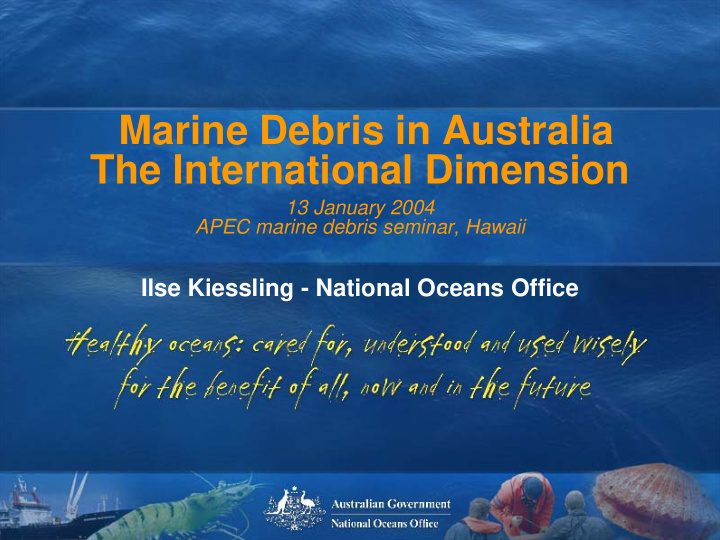



Marine Debris in Australia The International Dimension 13 January 2004 APEC marine debris seminar, Hawaii Ilse Kiessling - National Oceans Office
National Oceans Office • Commonwealth Government agency • Responsible for implementation of Australia’s Oceans Policy • Regional marine planning is the principal tool for implementing Australia’s Oceans Policy • Marine debris has emerged as a key theme through the regional marine planning process for northern Australia
Origins of marine debris around Australia Across Australian waters: • 13 800 tonnes of waste is generated aboard ships per year • 2 400 tonnes of fishing gear is lost or discarded • only 9 800 tonnes of debris are recovered over berths and disposal to landfills • so that up to 6 500 tonnes of waste per year is lost or discarded overboard (ANZECC, 1996)
Origins of marine debris around Australia • In general, approx. 80% of marine debris around Australia is terrestrial in origin • In northern Australia most debris (up to 99%) is likely to be from marine activities
Papua New Guinea Papua New Guinea • Map of northern Australia Indonesia Indonesia East Timor East Timor Arafura Sea Arafura Sea Indian Ocean Pacific Ocean Indian Ocean Pacific Ocean Australia Australia New Zealand New Zealand
Origins of marine debris in northern Australia In northern Australia • the fishing industry is likely to be responsible for the majority of debris
Origins of marine debris in northern Australia • coastal and offshore shipping are also significant sources of debris • most debris is likely to originate beyond Australian waters
Impacts of marine debris around Australia Many people share a concern about the impacts of debris on: • public safety • navigation • tourism and fishing industries • marine habitats and wildlife
Impacts of marine debris in northern Australia Indigenous people are particularly concerned about the impacts of debris on animals and environments “ We are the ones on the ground looking out and seeing all this marine debris coming in. We are the ones who are affected. We and our marine species as well” (Nanikiya Munungurritj)
Impacts of marine debris around Australia • Derelict fishing gear is the most hazardous type of debris to marine species • In southern Australia, approx. 1500 Australian sea lions and New Zealand fur seals are being entangled each year
Impacts of marine debris in northern Australia • In northern Australia, more than 700 marine turtles have been entangled since 1996
Australian responses to marine debris Domestic initiatives • research and non-government activities including: · seal entanglement studies (eg. Page et al., in press) · turtle entanglement studies (eg. Roeger, 2002) · A Fishing Net Identification Kit for Northern Australia (WWF, 2002)
Australian responses to marine debris • Natural Heritage Trust • Reviews and reports, including, ‘ Finding Solutions to Derelict Fishing Gear and other Marine Debris in Northern Australia ’ (Kiessling, 2003) • ‘Injury and fatality to vertebrate marine life caused by ingestion of, or entanglement in, harmful marine debris’ listed as a key threatening process under the Environment Protection and Biodiversity Conservation Act 1999
Australian responses to marine debris Australian domestic responses to the issue of marine debris have been driven by: • High quantities of debris • Increasing impacts of debris • Strong community concern and involvement • Clear identification of common areas of concern • Collaboration between multiple groups
Australian responses to marine debris International initiatives • …
Options to address marine debris in the APEC region Science and policy • mapping of wind and drift patterns • mapping of fishing operations • analysis of socio-economic drivers of polluting behaviour • collaboration between gear experts and surveillance operations to verify source of derelict fishing gear • ‘tagging’ or other permanent identification marking of fishing gear
Options to address marine debris in the APEC region Fishing gear and practices • financial incentives to encourage retrieval, return and recycling of vessel sourced waste • market-based incentives
Options to address marine debris in the APEC region Ports and disposal • analysis of the need for port facilities throughout the APEC region for efficient disposal of vessel- sourced waste • fishing gear repair, re-use and recycling initiatives at key ports
Options to address marine debris in the APEC region Domestic and international regulatory structures • analysis of the effectiveness of existing legal, regulatory and management regimes • identify opportunities for more effective implementation of MARPOL Annex V in the APEC region • joint activity between APEC working groups
Recommend
More recommend